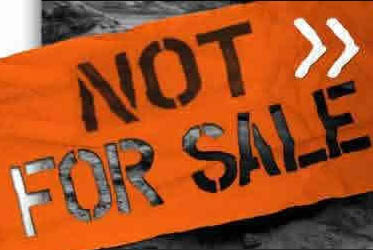Modern Slavery Expert Speaks at Westmont
Tells Students of Human Trafficking, Sex Servitude

Declared as ratified by the necessary majority of states on December 18, 1865, the 13th Amendment to the U.S. Constitution became law, officially abolishing slavery in the United States. The only exception allowing involuntary servitude that was made in the amendment applied to inmates in penal institutions.
In an auditorium packed with Westmont students attending their mandatory chapel meeting this Wednesday, all eyes were focused on one man as he delivered a chilling recount of the very real existence of slavery in the modern world. Eyes widened as the audience was told that not only does slavery still exist, it happens in American own cities and towns.

According to David Batstone’s recently-released book Not for Sale, there are approximately 27 million people enslaved today. Stemming from his book, the Not for Sale Campaign focuses on human enslavement all over the globe. Batstone is quick to point out though, that he is not talking about slavery-like conditions, but actual slavery. Many of the enslaved exist in the most mundane suburban homes and are subjected to what is essentially indentured servitude. However, Batstone’s figures show that nearly half of the people who are enslaved are unwillingly enrolled in the sex trade-and a third of those are minors.
Although he has been involved in human rights activism since the early 1980s, Batstone-a Westmont alumnus and professor of ethics at the University of San Francisco-became what he calls a modern-day abolitionist fairly recently. A seasoned traveler, he has found various forms of slavery in existence all over the globe. From child soldiers in Africa to child prostitutes in Asia, he has seen the full potential of man’s capacity for inhumanity. What shocked him most, he said, was learning that the owners of his favorite restaurant in San Francisco were enslaving young Asians and using them as employees. Coerced with physical violence and threats against their families, the workers were forced to stay locked in a crowded apartment when they weren’t working, and weren’t allowed contact with their families.
These were the fortunate ones. Delving further into the world of slavery within US borders, Batstone began doing research with the aid of his students. Combing through all kinds of different information-even ads on Craigslist.org-they found that certain key phrases led to people who were doing illegal things. One such Craigslist ad led Batstone and his team of volunteers to a brothel in the heart of San Francisco which specialized in the peddling of teenage prostitutes. Batstone decided to act. Armed with a hidden video camera and a suit, he entered the brothel pretending to be a wealthy businessman in search of a good time. He said that his goal was to get the proprietors to allow him to take a group of the underage girls back to his “hotel” with him, but he had to settle for gathering evidence of the transaction with his camera onsite.
Taking his evidence to law enforcement authorities, Batstone was disappointed with the result. “The problem is that the police have distinct categories of illegal alien vs. citizen, and prostitute vs. woman of virtue,” he said. He went on to explain that aside from actually finding victims of human trafficking, the biggest challenge faced by abolitionists is getting cooperation from law enforcement and immigration authorities. Batstone said modern salves are often treated as criminals and illegal aliens, and are deported back to their home countries-in many cases right back into the hands of the traffickers who pressed them into service in the first place. The Trafficking Victims Protection Act of 2000 (TVPA) was created to provide protection for victims of human trafficking. Furthermore, in 2002, the Department of Justice began issuing “T Visas” to some of these victims to prevent them from being automatically deported as illegal aliens.
Batstone maintains that the T Visas, while a good idea in theory, are difficult to utilize in most situations. “There are conditions for qualification,” he said. “They have to participate in the conviction of the traffickers after proving that the traffickers were actually engaged in the act. A lot of victims are just too traumatized to want to ever hear about their abusers again, and many of them have never even seen the traffickers.”
Becoming involved in human rights campaigns in his native Peru, Luis Enrique Bazan is the campaign’s executive director. “There’s a lot of talk about simple exploitation going on, but when you really look at it, there is slavery,” Bazan said. “Slavery is part of our society still; that’s why I feel that raising awareness is so important.” Bazan said that their investigations of the slave trade in the U.S. are heavily reliant upon student research. “Every place has its own unique problems,” he said. “For example, in San Francisco, there are a lot of transgender victims.”
Batstone indicated that many have volunteered to help out with the campaign, but that they receive much of their funding from philanthropic organizations. “We get a lot of donations from individuals and churches as well,” he said, “It’s a real grassroots effort.” He maintains that by keeping a high profile, other abolitionists will gain the courage they need to continue the fight against human trafficking.
For more information about the Not for Sale Campaign, visit its website.



